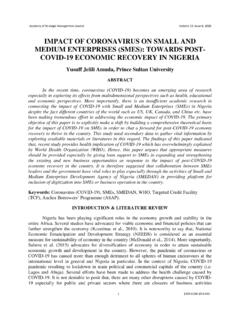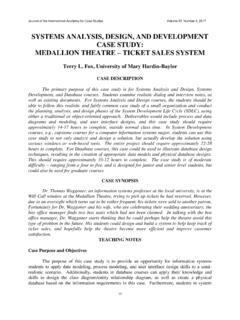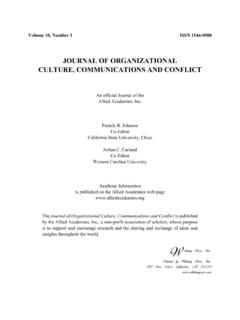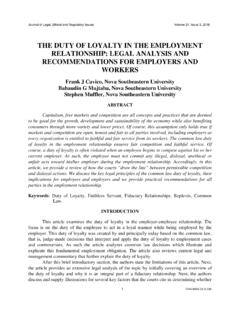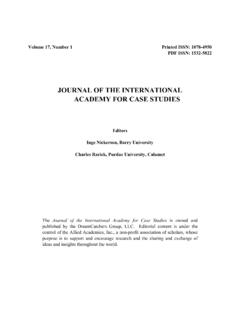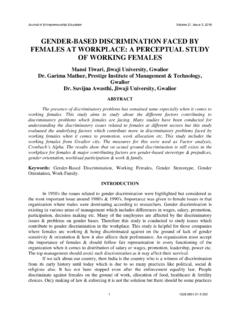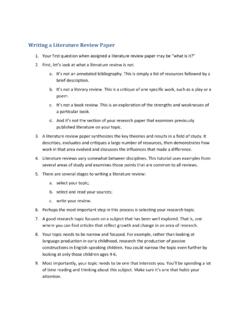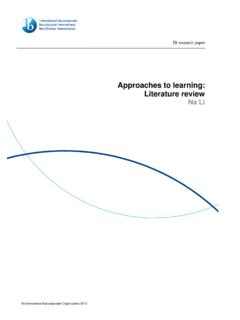Transcription of THE EFFECTS OF LEADERSHIP STYLES ON TEAM …
1 Academy of Strategic Management Journal Volume 16, Issue 2, 2017 1 1939-6104-16-2-113 THE EFFECTS OF LEADERSHIP STYLES ON team motivation Dana Al Rahbi, Abu Dhabi University Khalizani Khalid, Abu Dhabi University Mehmood Khan, Abu Dhabi University ABSTRACT This paper addresses a gap in the literature by exploring the dynamic LEADERSHIP theory comprising of the three classical STYLES -democratic, authoritarian and laissez-faire and their relationship to team motivation in the context of the healthcare sector of Abu Dhabi.
2 We review the best-known perspectives in the literature on team motivation and extant theories of LEADERSHIP STYLES with culture as a moderator to the model that is illustrated in the conceptual framework of this paper. An overview of theories is suggested in the model, and their impact on team motivation . Other findings that correlate the LEADERSHIP STYLES with team motivation include an understanding of the style expected to hold true for its importance in employee performance and retention in the long term.
3 This paper is the only attempt to date that explores the EFFECTS of the four LEADERSHIP STYLES on team motivation . Keywords: team motivation , Dynamic LEADERSHIP , LEADERSHIP Style, LEADERSHIP Theories, Culture, Healthcare Sector, United Arab Emirates INTRODUCTION Research on LEADERSHIP is becoming increasingly common among healthcare professionals (Schneider & Somers, 2006; Uhl-Bien & Marion, 2009). Scholars claim that this perspective is crucial for addressing team motivation in the context of an increasingly turbulent and rapidly changing healthcare services sector (Lichtenstein & Plowman, 2009; Hanson & Ford, 2010).
4 Moreover, team motivation in knowledge-intense organizations is rarely discussed due to the complex nature existing between perspectives on LEADERSHIP and organizational culture in the healthcare industry (Greenfield, 2007). Hanson & Ford (2010) discussed that the highly complex networks between bureaucratic organizational structures and LEADERSHIP conventions interactively and mutually support the acceleration of organizational outcomes that lead to successful team motivation (Hanson & Ford, 2010). Enacting effective LEADERSHIP can drive improvements in team motivation and greatly benefit the dynamics of organizational culture in health care practices (K rner et al.)
5 , 2015). For healthcare professionals, the challenge in the composition of team motivation is in overcoming the LEADERSHIP expectations inherited while maintaining the statusquo in a multi-professional rehabilitation organization (Strasser et al., 2005). The healthcare industry representsa set of organisations that are conventionally shaped by the bureaucratic model, separating organisation of work from delivery of work(Penprase & Norris, 2005; Uhl-Bien et al., Academy of Strategic Management Journal Volume 16, Issue 2, 2017 2 1939-6104-16-2-113 2007).
6 In other words, LEADERSHIP is characterised bya top-down approach (Millward & Bryan, 2005; Murphy, 2005) to achieve maximum unit efficiency (Butler, 2008). Therefore, environments where LEADERSHIP behavior is constrained by outdated management concepts may limit critical organizational culture dynamics that facilitate the achievement of positive team motivation . In other words, health care organizations gained less from spending on the efforts and resources used for improving the outcomes with the help of traditional LEADERSHIP methods (Burns, 2001).
7 In order to improve the outcome, there must be a shift from the traditional LEADERSHIP models to modern LEADERSHIP models. The healthcare professionals have to meet the changing demands of the patients, therefore they should focus on catalyzing the process of problem solving, collaboration, team management, and creativity, among others, to become central to efficacious team motivation . (Lemieux-Charles & McGuire, 2006). Successful adaptation of multi-disciplinary team motivation does not necessarily mean organizational restructuring or enhancing an individual s professional or managerial skills and competencies.
8 A multi-professional team level involves professionals of different disciplines who work separately in nature, but work together to achieve organizational outcomes (Epstein, 2014; Tzenalis & Sotiriadou, 2010). team motivation in the healthcare services industry leads complex adaptive organizations through dynamic processes that require leaders to view both organizations and LEADERSHIP from different perspectives. Hall (1999) notes that leaders need to understand the importance of a revolutionary management style that encompasses changes in behavioral processes, mediated by the dynamic of organisational culture that affects outcomes.
9 These key causal relations impact the inter-departmental or environmental boundaries of the healthcare industry. Evidence suggests that leaders must counter the current LEADERSHIP STYLES to understand the behavior of healthcare professionals typically by transforming the corporate practices by involving the informal leaders. Further, holistic team motivation can be harnessed by increasing the organizational adaptive capacity (Uhl-Bien et al., 2007; Schreiber & Carley, 2008; Tsai, 2011; Al-Sawai, 2013).
10 This paper argues that most studies on team motivation emphasize team work, linking it to job satisfaction (Korner, 2010; K rner et al., 2015), patient safety (Manser, 2009), team climate and team efficiency (Poulton & West , 1999). Few studies have investigated the EFFECTS of dynamic LEADERSHIP on the role of multi-professional team motivation in healthcare organizations. Earlier research on LEADERSHIP has produced normative statements on how LEADERSHIP should be undertaken (Oliver, 2006; Al-Sawai, 2013).
